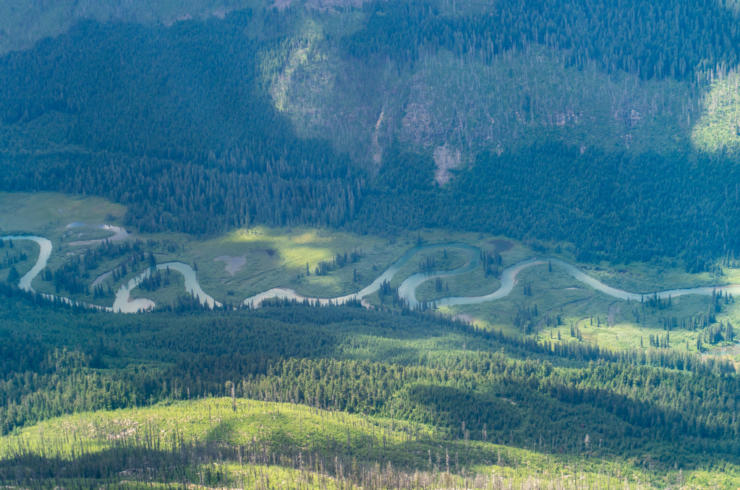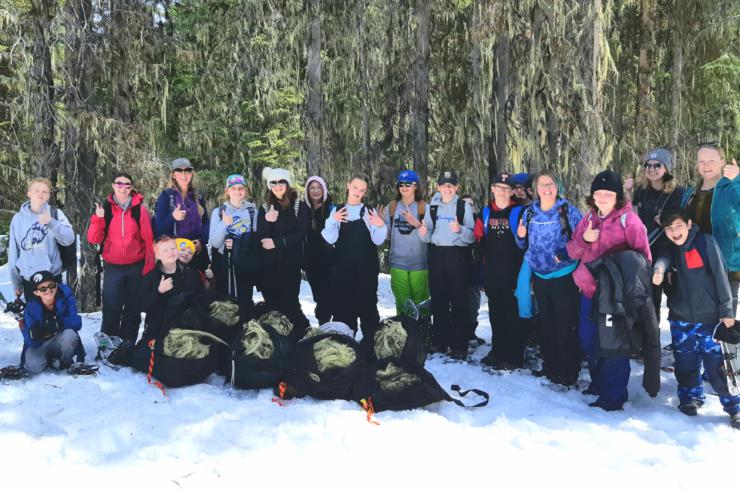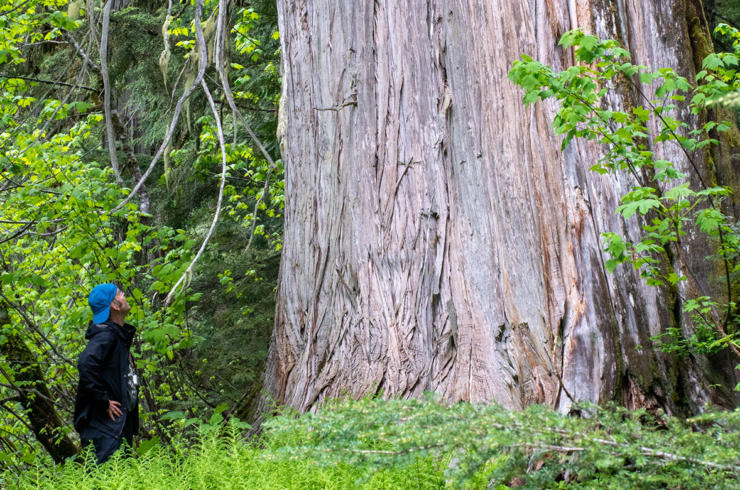What are mountain caribou?
Mountain caribou are an ‘ecotype’ of woodland caribou that inhabit the deep snowbelt regions of the interior rainforest of British Columbia and parts of three US states. Their large hooves act as snowshoes that allow them to spend winters high in the subalpine and alpine forests, where snowpacks can reach depths up to four meters. The deep snows act as a barrier to predators, and as a platform that allows the caribou to reach their winter food source, lichens that grow on old-growth trees. Mountain caribou are the only member of the deer family to move to higher elevations in winter.
Where do they live?
Mountain caribou inhabit the Inland Temperate Rainforest, which is primarily found in BC. The intense precipitation, deep snows in winter, and mountainous, forested terrain is ideal habitat for mountain caribou. A part of the Inland Temperate Rainforest, Wells Gray Provincial Park, has been recommended for World Heritage status. The rainforest is home to hundreds of species of plants and animals, some of the, like mountain caribou, rare and unique.
Do mountain caribou migrate?
Mountain caribou do not undertake extensive migrations like their northern cousins, which may migrate thousands of kilometers each year. Instead, mountain caribou move up and down the mountains throughout the seasons. For most of the year caribou can be found on the mid-to-upper slopes in the wet old growth forests of the interior mountains.
In early winter when the snow is deep but too soft to stand on, the caribou move down to the valley bottoms and eat ground plants such as falsebox. When the snowpack solidifies enough to support their weight the animals move back upslope. They move down again in early spring to feed on succulent plants as the snow melts. In May and June they again move upslope, to give birth to their calves.
What do mountain caribou eat?
Caribou prefer tender, more palatable food sources, as opposed to moose and elk, which can browse on the coarsest of alder and willow bark. During the spring and summer months, caribou prefer herbs such as arnica, willow and groundsel. When the snows arrive in early winter caribou paw down to feed on shrubs such as falsebox. In mid- to late-winter, when their ground-based foods are buried in snow, mountain caribou live almost entirely on arboreal lichens (lichens that hang from trees), such as Witches Hair and Old Man’s Beard. Seasonal movements, habitat use, old-growth dependence and late winter feeding habits make mountain caribou globally unique.
What’s the difference if caribou become locally extinct in BC’s inland rainforests? There will still be thousands up north and besides, don’t animals go extinct all the time?
Scientists have repeatedly pointed out that protecting caribou habitat will benefit many other wildlife species that live on the same landscape and are suffering from the same threats. Habitat protection for mountain caribou will provide not only a more certain future for mountain caribou but also numerous other valuable wildlife species in the inland rainforest ecosystem. Mountain caribou reside nowhere else in the world. Only Canadians, and British Columbians in particular, have the chance to conserve this species.
Around the world many countries with less wealth than Canada have risen to the challenge and are taking steps to secure the future of species such as gorillas, tigers, and rhinos. We have an opportunity to secure the future of many wildlife species in a single step by addressing the needs of mountain caribou. By doing so we will be playing our part as global citizens, recognizing the value of our natural environment and protecting it for future generations. We can play our part, addressing the global problem of species loss by acting locally to protect our own endangered species.
Wilderness areas support our quality of life. Conserving caribou habitat also protects the recreational, spiritual and visual benefits of wild forests and ecosystems. This local quality of life is like a second paycheque that attracts investment, and supports a diverse workforce and strong economies. Forest ecosystems also provide such basic necessities as clean water and clean air. And in this time of global warming, why cut down these forests and release more carbon?
What is happening to protect caribou?
The BC government has legislated initial habitat protections, protecting millions of acres of caribou habitat from road building and logging. Winter motorized recreation tenures in critical habitat remain an obstacle to ensuring this habitat is available for caribou use. Mountain Caribou Project member groups are working to ensure government recognizes wildlife scientists’ recommendations regarding areas important to close to motorized recreation to protect mountain caribou during a season when their health and survival is at risk.
What can I do?
Talk about mountain caribou to friends and neighbors so everyone knows about this wonderful animal on the edge. Lend strong support to groups and organizations that are acting to protect our wildlife heritage.
Contact commercial backcountry tourism operators and let them know that the health of mountain caribou and all wildlife within their tenure on public lands must be a management priority.
Communicate with your government officials, the Premier’s office, your MLAs and agency officials. Urge the government to follow the plan’s recommendations on limited recreation, mining, and other activities in mountain caribou critical habitat to further protect caribou.








